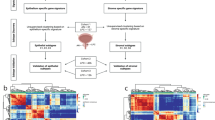Abstract
Purpose
The aim of the study was to correlate nuclear matrix (NM) protein expression profiles with the risk of PSA progression or death in early prostate cancer (PCa).
Methods
High-resolution two-dimensional gel electrophoresis (2D-PAGE) was used to identify tumor-associated NM proteins in the PCa specimens obtained from 94 patients. The association between the expression of each protein and the probability of PSA progression or death was studied through univariate analysis. Unsupervised hierarchical clustering analysis was then used to generate patient clusters showing comparable outcomes by including the proteins that were predictive at univariate analysis. PSA-free and overall survival curves relative to each cluster were constructed by means of the Kaplan–Meier method and curves compared by the log-rank test. Multi-parametric models were constructed according to Cox proportional hazard technique.
Results
After a median follow-up of 11.7 years (range, 6.5–16.2), 50 patients progressed and 22 died. Of the eight NM proteins identified through 2D-PAGE, proteins NM-6, NM-7 and NM-8 were confirmed to be individually associated with a higher risk of PSA progression at univariate analysis. Proteins NM-6 and NM-8 were also predictive of survival probability. Hierarchical clustering analysis of these proteins allowed to identify one cluster of tumors co-expressing the three proteins or proteins NM-6 and NM-8, characterized by a very poor outcome, suggesting a specific role for these proteins in PCa progression. The predictive value of this mini-signature in respect to PSA-free survival was confirmed by multivariate analysis.
Conclusions
Changes in NM scaffolding are strongly associated with the clinical outcome of patients following radical prostatectomy.


Similar content being viewed by others
References
Alberti I, Barboro P, Barbesino M et al (2000) Changes in the expression of cytokeratins and nuclear matrix proteins are correlated with the level of differentiation in human prostate cancer. J Cell Biochem 79(3):471–485
Barboro P, Rubagotti A, Boccardo F et al (2005) Nuclear matrix protein expression in prostate cancer: possible prognostic and diagnostic applications. Anticancer Res 25(6B):3999–4004
Barboro P, Repaci E, Rubagotti A et al (2009) Heterogeneous nuclear ribonucleoprotein K: altered pattern of expression associated with diagnosis and prognosis of prostate cancer. Br J Cancer 100(10):1608–1616
Boccardo F, Rubagotti A, Carmignani G et al (2003) Nuclear matrix proteins changes in cancerous prostate tissues and their prognostic value in clinically localized prostate cancer. Prostate 55(4):259–264
Bomsztyk K, Denisenko O, Ostrowski J (2004) hnRNP K: one protein multiple processes. BioEssays 26(6):629–638
Bostwick DG, Grignon DJ, Hammond ME et al (2000) Prognostic factors in prostate cancer. College of American Pathologists Consensus Statement 1999. Arch Pathol Lab Med 124(7):995–1000
Carpenter B, McKay M, Dundas SR, Lawrie LC, Telfer C, Murray GI (2006) Heterogeneous nuclear ribonucleoprotein K is over expressed, aberrantly localised and is associated with poor prognosis in colorectal cancer. Br J Cancer 95(7):921–927
Chen LC, Hsueh C, Tsang NM et al (2008) Heterogeneous ribonucleoprotein k and thymidine phosphorylase are independent prognostic and therapeutic markers for nasopharyngeal carcinoma. Clin Cancer Res 14(12):3807–3813
Cox DR (1972) Regression models and life tables. J R Stat Soc 34:187–220
Heukeshoven J, Dernick R (1988) Improved silver staining procedure for fast staining in Phast System Development Unit I. Staining of sodium dodecyl sulfate gels. Electrophoresis 9:28–32
Humphrey PA (2004) Gleason grading and prognostic factors in carcinoma of the prostate. Mod Pathol 17(3):292–306
Humphrey PA, Vollmer RT (1997) Percentage of carcinoma as a measure of prostatic tumor size in radical prostatectomy tissues. Mod Pathol 10:326–333
Jemal A, Siegel R, Xu J, Ward E (2010) Cancer statistics, 2010. CA Cancer J Clin 60(5):277–300
Kaplan EL, Meier P (1958) Nonparametric estimation from incomplete observations. J Am Stat Assoc 53:457–481
Leman ES, Getzenberg RH (2008) Nuclear structure as a source of cancer specific biomarkers. J Cell Biochem 104(6):1988–1993
Montironi R, Mazzuccheli R, Scarpelli M, Lopez-Beltran A, Fellegara G, Algaba F (2005) Gleason grading of prostate cancer in needle biopsies or radical prostatectomy specimens: contemporary approach, current clinical significance and sources of pathology discrepancies. BJU Int 95(8):1146–1152
Mukhopadhyay NK, Kim J, Cinar B, Ramachandran A, Hager MH, Di Vizio D (2009) Heterogeneous nuclear ribonucleoprotein K is a novel regulator of androgen receptor translation. Cancer Res 69(6):2210–2218
Partin AW, Getzenberg RH, CarMichael MJ et al (1993) Nuclear matrix protein patterns in human benign prostatic hyperplasia and prostate cancer. Cancer Res 53:744–746
Peto R, Pike MC, Armitage P et al (1976) Design and analysis of randomised clinical trials requiring prolonged observation of each patient: I. Introduction and design. Br J Cancer 34:585–612
Peto R, Pike MC, Armitage P et al (1977) Design and analysis of randomised clinical trials requiring prolonged observation of each patient: II. Analysis and examples. Br J Cancer 35:1–39
Tefilli MV, Gheiler EL, Tiguert R et al (1999) Should Gleason score 7 prostate cancer be considered a unique grade category? Urology 53:372–377
Acknowledgments
This work was partially supported by grants from Italian Health Minister (Grant number 2005 conv. 93; 2005 conv. 65); Italian Education, University and Research Minister (Grant number: 9806118184 and 2008YFRLC8-004); Liguria Region, Department of Health (Grant number: 563/2009); “Compagnia di San Paolo”, Italy (Grant number: 2009.1271).The authors are indebted to Dr Claudia Casella (Descriptive Epidemiology Unit: Tumor Registry, IRCCS San Martino University Hospital—IST National Cancer Research Institute, Genoa, Italy) for helping in data collection and to Mrs Suzanne Patten for reviewing the English format.
Conflict of interest
The authors declare no conflicts of interest.
Author information
Authors and Affiliations
Corresponding author
Rights and permissions
About this article
Cite this article
Ricci, F., Rubagotti, A., Zinoli, L. et al. Prognostic value of nuclear matrix protein expression in localized prostate cancer. J Cancer Res Clin Oncol 138, 1379–1384 (2012). https://doi.org/10.1007/s00432-012-1216-0
Received:
Accepted:
Published:
Issue Date:
DOI: https://doi.org/10.1007/s00432-012-1216-0




